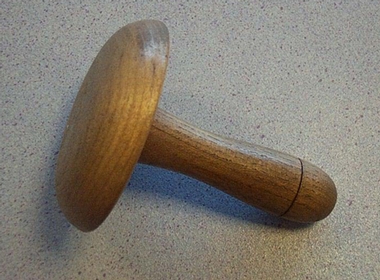Okay, I gotta admit, I asked for this one. At Perryville, and rather emphatically.
In fact, I looked at those pitiful socks, full of holes and caked with what I hope fervently was horse manure, and said "Give me those socks, you can't be going around like that"
So, it took an afternoon of careful soaking and scrubbing to get the horse manure out of them without shrinking them.
Then, the weather being what it is, it took them 3 days to dry on my largest wooden sock blocks. The ones eveybody laughed at when I got them and said nobody had feet that long.
Yeah they do. And feet that long can wear some big ol' longggggg holes.
Then I picked out the original attempt at mending the socks. That attempt had produced nothing more than a lump the size of a golf ball on the bottom of the foot. Never send a man to do a woman's job.
Then, I finally got down to the pleasure of sock mending. This means I get to get out little bitsy balls of hoarded handspun, match the yarn size (good luck on color--ain't happening) and go to work picking up stitches and reknitting the heel.
Then go find a smaller, single spun yarn, and darn all the weak spots in the toes and other wear spots. Its a great deal easier to fix socks at this point, when they start getting thin, rather than when they've got big gaping holes in them.
So, they are all done. Took me nearly as long to wash and mend them as it would have to knit a new pair, from ready made yarn--but if I was making them from scratch, I'd have had two more days in the spinning.
And in 1860, time is cheap, and materials are expensive.
Excellent exercise with an otherwise useless pair of socks. And, once cleaned, mended, and reblocked, they look pretty good.
And that's because they were well-made originally--high quality wool, hand knit, with a fine period heel rather than a short cut modern heel. Had they been modern heeled socks, I'd never have given them a second look, never mind offered to mend them.
And, the leg and the top of the foot was still sound, with long wear left. I don't know the maker, but I know an awful lot about her, from the quality of her work.
Wonderful way to spend a cold rainy evening----and to think of the countless others who did the same.
In fact, I looked at those pitiful socks, full of holes and caked with what I hope fervently was horse manure, and said "Give me those socks, you can't be going around like that"
So, it took an afternoon of careful soaking and scrubbing to get the horse manure out of them without shrinking them.
Then, the weather being what it is, it took them 3 days to dry on my largest wooden sock blocks. The ones eveybody laughed at when I got them and said nobody had feet that long.
Yeah they do. And feet that long can wear some big ol' longggggg holes.
Then I picked out the original attempt at mending the socks. That attempt had produced nothing more than a lump the size of a golf ball on the bottom of the foot. Never send a man to do a woman's job.
Then, I finally got down to the pleasure of sock mending. This means I get to get out little bitsy balls of hoarded handspun, match the yarn size (good luck on color--ain't happening) and go to work picking up stitches and reknitting the heel.
Then go find a smaller, single spun yarn, and darn all the weak spots in the toes and other wear spots. Its a great deal easier to fix socks at this point, when they start getting thin, rather than when they've got big gaping holes in them.
So, they are all done. Took me nearly as long to wash and mend them as it would have to knit a new pair, from ready made yarn--but if I was making them from scratch, I'd have had two more days in the spinning.
And in 1860, time is cheap, and materials are expensive.
Excellent exercise with an otherwise useless pair of socks. And, once cleaned, mended, and reblocked, they look pretty good.
And that's because they were well-made originally--high quality wool, hand knit, with a fine period heel rather than a short cut modern heel. Had they been modern heeled socks, I'd never have given them a second look, never mind offered to mend them.
And, the leg and the top of the foot was still sound, with long wear left. I don't know the maker, but I know an awful lot about her, from the quality of her work.
Wonderful way to spend a cold rainy evening----and to think of the countless others who did the same.




Comment